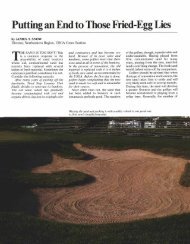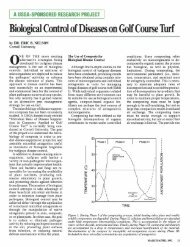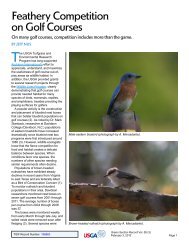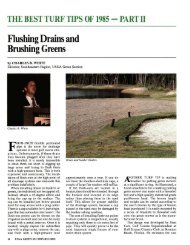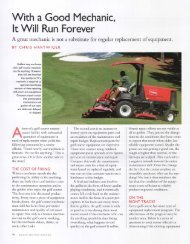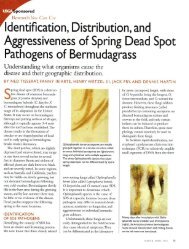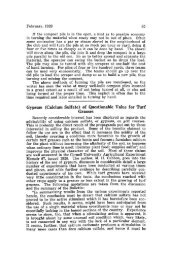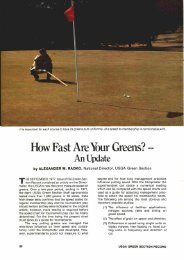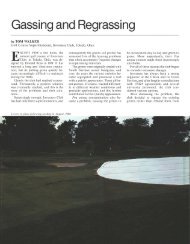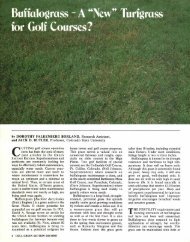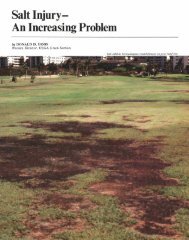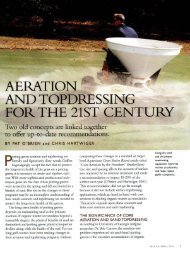Create successful ePaper yourself
Turn your PDF publications into a flip-book with our unique Google optimized e-Paper software.
148 BULLETIN OF GREEN SECTION OF THE [Vol. II, No.5<str<strong>on</strong>g>The</str<strong>on</strong>g> <str<strong>on</strong>g>Effect</str<strong>on</strong>g> <str<strong>on</strong>g>of</str<strong>on</strong>g> <str<strong>on</strong>g>Trampling</str<strong>on</strong>g> <str<strong>on</strong>g>and</str<strong>on</strong>g> <str<strong>on</strong>g>Rolling</str<strong>on</strong>g> <strong>on</strong> <strong>Turf</strong>DR.. WALTER S. HARBANIt has always been a mooted questi<strong>on</strong> whether to roll or not to ro~l.Some hold that turf prospers better in light loamy soil, <str<strong>on</strong>g>and</str<strong>on</strong>g> others agamas str<strong>on</strong>gly advocate a moderately compact <strong>on</strong>e. I must say that myexperience prompts me to accept the latter view, What may be favor~blefor lawn turf can not be c<strong>on</strong>sidered in turf for golf courses,as the reqUIrementsare as different as day from night. I can not c<strong>on</strong>ceive how a perfectputting surface can be developed or maintained without rolling. A certaincompactness <str<strong>on</strong>g>of</str<strong>on</strong>g> surface apparently tends to produce a finer, denserturf. whereas in loose soil the plants are coarser <str<strong>on</strong>g>and</str<strong>on</strong>g> stalky. Howeverthes~ things may be, a golf course is designed to meet certain requirements,<str<strong>on</strong>g>and</str<strong>on</strong>g> the turf must withst<str<strong>on</strong>g>and</str<strong>on</strong>g> the hardest usage to which grass can besubjected.Since putting greens are very severely compacted by players ~<strong>on</strong>stantlywalking over them, it would not seem unreas<strong>on</strong>able to use faIrlyheavy rollers at times j first, to prevent deep foot or heel prints, <str<strong>on</strong>g>and</str<strong>on</strong>g> sec<strong>on</strong>dlyto smooth out those that are made when the ground is moist or s<str<strong>on</strong>g>of</str<strong>on</strong>g>t.I can not think that many <str<strong>on</strong>g>of</str<strong>on</strong>g> us have appreciated how great is the loadper square inch <str<strong>on</strong>g>of</str<strong>on</strong>g> a man's foot <str<strong>on</strong>g>and</str<strong>on</strong>g> what it means to a green to haveseveral hundred players tramping <strong>on</strong> it every day <str<strong>on</strong>g>and</str<strong>on</strong>g> <str<strong>on</strong>g>of</str<strong>on</strong>g>te?- thro"?-g~outthe year. <str<strong>on</strong>g>The</str<strong>on</strong>g> ground is necessarily much compacted, especIally wIt111naradius <str<strong>on</strong>g>of</str<strong>on</strong>g> five or ten feet <str<strong>on</strong>g>of</str<strong>on</strong>g> the hole. To present this phase <str<strong>on</strong>g>of</str<strong>on</strong>g> the subjectmore fully, Dr. Lyman J. Briggs, <str<strong>on</strong>g>of</str<strong>on</strong>g> the U. S. Bureau <str<strong>on</strong>g>of</str<strong>on</strong>g> St<str<strong>on</strong>g>and</str<strong>on</strong>g>ards, haskindly worked out some very interesting data <strong>on</strong> the relati<strong>on</strong> <str<strong>on</strong>g>of</str<strong>on</strong>g> weight topressure, <str<strong>on</strong>g>and</str<strong>on</strong>g> which, with his c<strong>on</strong>sent, I take pleasure in introducing here.Note <strong>on</strong> the <str<strong>on</strong>g>Effect</str<strong>on</strong>g>ive Load Secured in <str<strong>on</strong>g>Rolling</str<strong>on</strong>g> a Putting GreenDR. LYMAN J. BRIGGS<str<strong>on</strong>g>The</str<strong>on</strong>g> following simple computati<strong>on</strong>s have been made for the purpose <str<strong>on</strong>g>of</str<strong>on</strong>g> formingan approximate idea <str<strong>on</strong>g>of</str<strong>on</strong>g> the loading to which a putting green is subjectedduring the process <str<strong>on</strong>g>of</str<strong>on</strong>g> roIling.<str<strong>on</strong>g>The</str<strong>on</strong>g> limiting c<strong>on</strong>diti<strong>on</strong>s encountered in rolling are represented diagramaticallyin Figures 1 <str<strong>on</strong>g>and</str<strong>on</strong>g> 2. Figure 1 represents a smooth cylinder roller <strong>on</strong> ahard, smooth, horiz<strong>on</strong>tal surface. <str<strong>on</strong>g>The</str<strong>on</strong>g> limiting c<strong>on</strong>diti<strong>on</strong> in this case would be aline c<strong>on</strong>tact between the roller <str<strong>on</strong>g>and</str<strong>on</strong>g> the surface, in which case the loading wouldapproach infinity, But, <str<strong>on</strong>g>of</str<strong>on</strong>g> course, such a c<strong>on</strong>diti<strong>on</strong> is not actually realized, sinceboth the roller <str<strong>on</strong>g>and</str<strong>on</strong>g> the surface deform to produce a surface <str<strong>on</strong>g>of</str<strong>on</strong>g> c<strong>on</strong>tact, <str<strong>on</strong>g>and</str<strong>on</strong>g> theloading falls <str<strong>on</strong>g>of</str<strong>on</strong>g>f inversely proporti<strong>on</strong>al to the width <str<strong>on</strong>g>of</str<strong>on</strong>g> the surface <str<strong>on</strong>g>of</str<strong>on</strong>g> c<strong>on</strong>tact.A sec<strong>on</strong>d limiting c<strong>on</strong>diti<strong>on</strong> is represented in Figure 2, in which the greenis supposed to possess no resiliency <str<strong>on</strong>g>and</str<strong>on</strong>g> to be compressed as indicated in thediagram as the roller proceeds from left to right over its surface. If the greenpossessed no resiliency the roller would be in c<strong>on</strong>tact with the green <strong>on</strong>ly throughthe sector indicated by the angle a in Figure 2.<str<strong>on</strong>g>The</str<strong>on</strong>g> actual c<strong>on</strong>diti<strong>on</strong>s are more nearly represented by Figure 3, in which thegreen is c<strong>on</strong>sidered to possess some resiliency <str<strong>on</strong>g>and</str<strong>on</strong>g> to rise up behind the roller asthe latter passes over it. It is evident that under such c<strong>on</strong>diti<strong>on</strong>s the bearing' surfaceis greatly increased <str<strong>on</strong>g>and</str<strong>on</strong>g> the loading (that is, the weight <str<strong>on</strong>g>of</str<strong>on</strong>g> the roller dividedby the projected bearing surface) is corresp<strong>on</strong>dingly decreased. It has been assumedin the calculati<strong>on</strong>s that this resiliency increases the actual bearing surfaceby 50 per cent over the c<strong>on</strong>diti<strong>on</strong> as represented in Figure 2. We shall call thevertical distance from the surface <str<strong>on</strong>g>of</str<strong>on</strong>g> the undisturbed green to the bottom <str<strong>on</strong>g>of</str<strong>on</strong>g> theroller the depth <str<strong>on</strong>g>of</str<strong>on</strong>g> imbedding <str<strong>on</strong>g>of</str<strong>on</strong>g> the roller. Let us represent this distance by d.Let r equal the radius <str<strong>on</strong>g>of</str<strong>on</strong>g> the roller, <str<strong>on</strong>g>and</str<strong>on</strong>g> a the included angle <str<strong>on</strong>g>of</str<strong>on</strong>g> the arc <str<strong>on</strong>g>of</str<strong>on</strong>g> c<strong>on</strong>tactin Figure 2. <str<strong>on</strong>g>The</str<strong>on</strong>g>n d...=r (I-cos a). If 8 is the projected surface <str<strong>on</strong>g>of</str<strong>on</strong>g> c<strong>on</strong>tact
May 17. 1922] UNITED STATES GOLF ASSOCIATION 149<strong>on</strong> a horiz<strong>on</strong>tal plane (Figure 2) <str<strong>on</strong>g>and</str<strong>on</strong>g> L is the length <str<strong>on</strong>g>of</str<strong>on</strong>g> the roller, we haveB = Lr sin a. If we assume that the loading is uniform over the projected surface<str<strong>on</strong>g>of</str<strong>on</strong>g> c<strong>on</strong>tact, the loading per square inch then will evidently be the weight w<str<strong>on</strong>g>of</str<strong>on</strong>g> the roller divided by B.In the numerical computati<strong>on</strong>s we have assumed a roller 2 feet in diameter,weighing 150 pounds per foot-length <str<strong>on</strong>g>of</str<strong>on</strong>g> roller. It has also been assumed thatthe form <str<strong>on</strong>g>of</str<strong>on</strong>g> c<strong>on</strong>tact is that shown in Figure 3 (that is, that the projected surface<str<strong>on</strong>g>of</str<strong>on</strong>g> c<strong>on</strong>tact for any given imbedding depth is 50 per cent greater than representedby the c<strong>on</strong>diti<strong>on</strong> shown in Figure 2). Using the equati<strong>on</strong>s given above <str<strong>on</strong>g>and</str<strong>on</strong>g> thenumerical values indicated, the loading has been computed for depths <str<strong>on</strong>g>of</str<strong>on</strong>g> imbeddingvarying from 1/100 inch to 1 inch. <str<strong>on</strong>g>The</str<strong>on</strong>g> results are given in the followingtable:RELATION OF LOAD TO IMBEDDING DEPTHP1'ojected su/rface Loading poundsImbedding depth <str<strong>on</strong>g>of</str<strong>on</strong>g> c<strong>on</strong>taet per square inch0.01 inch 8.7 sq. in. 17.2.05 20.0 7.5.10 28.0 5.4.20 39.5 3.8.30.4048.056.0:3.12.7.50 62.0 2.4.75 75.0 2.01.00 85.0 1.7It will be seen from the table that the imbedding <str<strong>on</strong>g>of</str<strong>on</strong>g> the roller in the greento the depth <str<strong>on</strong>g>of</str<strong>on</strong>g> 1/100 inch results in an average load over the surface <str<strong>on</strong>g>of</str<strong>on</strong>g> c<strong>on</strong>tact<str<strong>on</strong>g>of</str<strong>on</strong>g> 17.2 pounds per square inch. With an imbedding depth <str<strong>on</strong>g>of</str<strong>on</strong>g> <strong>on</strong>ly 1/10 inch theaverage loading falls <str<strong>on</strong>g>of</str<strong>on</strong>g>f to 5.4 pounds per square inch <str<strong>on</strong>g>and</str<strong>on</strong>g> decreases steadily asthe depth <str<strong>on</strong>g>of</str<strong>on</strong>g> imbedding is increased.When a man weighing 170 pounds supports his wei~ht <strong>on</strong> the baU <str<strong>on</strong>g>of</str<strong>on</strong>g> <strong>on</strong>e foothe develops a loading <strong>on</strong> the green beneath the sole <str<strong>on</strong>g>of</str<strong>on</strong>g> hIS shoe <str<strong>on</strong>g>of</str<strong>on</strong>g> about 13 poundsper square inch, since the area <str<strong>on</strong>g>of</str<strong>on</strong>g> c<strong>on</strong>tact <str<strong>on</strong>g>of</str<strong>on</strong>g> a sole <str<strong>on</strong>g>of</str<strong>on</strong>g> a shoe <str<strong>on</strong>g>of</str<strong>on</strong>g> average size is,roughly, 13 square inches. C<strong>on</strong>sequently, a man walking over a green developsa much greater loading over the surface which supports his weight than wouldbe developed by a roller <str<strong>on</strong>g>of</str<strong>on</strong>g> the size <str<strong>on</strong>g>and</str<strong>on</strong>g> weight described which settles into thegreen <strong>on</strong>ly 5/100 <str<strong>on</strong>g>of</str<strong>on</strong>g> an inch. It seems evident, therefore, that <strong>on</strong> a springy greenwhich allows the roller to sink into the green to a depth <str<strong>on</strong>g>of</str<strong>on</strong>g> <strong>on</strong>e-quarter <str<strong>on</strong>g>of</str<strong>on</strong>g> aninch or more, it would be necessary to employ a much heavier roller than the<strong>on</strong>e used in these computati<strong>on</strong>s in order to secure a loading greater than thatdeveloped by the players in walking over the green. In fact, if the compressi<strong>on</strong><str<strong>on</strong>g>of</str<strong>on</strong>g> the green is <strong>on</strong>e-quarter <str<strong>on</strong>g>of</str<strong>on</strong>g> an inch when the player is supporting his weight<strong>on</strong> the ball <str<strong>on</strong>g>of</str<strong>on</strong>g> <strong>on</strong>r;,foot, it would require a roller weighing about 550 pounds perlinear foot to give an equal average loading.Dr. Briggs does not c<strong>on</strong>tend that this load is equally distributed <strong>on</strong>aU parts <str<strong>on</strong>g>of</str<strong>on</strong>g> the projected surface as indicated in Figure 3, but distinctlysays, "if we assume that the loading is uniform over the projected surface." What difference this may make in his table "relati<strong>on</strong> <str<strong>on</strong>g>of</str<strong>on</strong>g> load toimbedding depth" he has promised to work out later.<str<strong>on</strong>g>The</str<strong>on</strong>g> vital points brought out by Dr. Briggs's deducti<strong>on</strong>s are:First, that <strong>on</strong> a hard, smooth, horiz<strong>on</strong>tal surface the loading per squaroinch is the greatest, <str<strong>on</strong>g>and</str<strong>on</strong>g> as the roller sinks into the surface, increasing thosurface <str<strong>on</strong>g>of</str<strong>on</strong>g> c<strong>on</strong>tact, it diminishes according to the imbedding depth.Sec<strong>on</strong>d, that a man weighing 170 pounds, walking over a puttinggreen, develops a loading under the ball <str<strong>on</strong>g>of</str<strong>on</strong>g> his foot <str<strong>on</strong>g>of</str<strong>on</strong>g> 13 pounds persquare inch; c<strong>on</strong>sequently, when the weight is carried, as it must be fora time, <strong>on</strong> the heel <str<strong>on</strong>g>of</str<strong>on</strong>g> the shoe, which has l!'ss than <strong>on</strong>e-half the area, theload is more than doubled, as evidenced by the greater depth <str<strong>on</strong>g>of</str<strong>on</strong>g> he!'l printswhen walking over s<str<strong>on</strong>g>of</str<strong>on</strong>g>t ground.Finally, that it will require a much heavier roller to !'qualize tlwse
150 BULLETIN OF GEIEN SECTION OF Till [Vol. n. No. SW///MMg. 1Fig. 2Fig. 3differences than any greenkeeperhas ever used or suggestedheret<str<strong>on</strong>g>of</str<strong>on</strong>g>ore.I wish to emphasize what Isaid <strong>on</strong> page 87, Volume II, No.3, <str<strong>on</strong>g>of</str<strong>on</strong>g> THE BULLETIN, as to earlyspring rolling, <str<strong>on</strong>g>and</str<strong>on</strong>g> to add that<strong>on</strong>e such treatment at Columbiathis spring was sufficient to putthe course in good shape to preventdeep foot impressi<strong>on</strong>s. Weshall not hesitate later to repeatthe rolling if the necessityshould arise. It is useless toroll when the ground is dry <str<strong>on</strong>g>and</str<strong>on</strong>g>hard. Wait until after a good,soaking rain, when the soil underthe turf will, if tightlysqueezed in the h<str<strong>on</strong>g>and</str<strong>on</strong>g>, crumblereadily by gentle pressure <str<strong>on</strong>g>of</str<strong>on</strong>g>the fingers. <str<strong>on</strong>g>The</str<strong>on</strong>g> ground canthen be rolled <str<strong>on</strong>g>and</str<strong>on</strong>g> will not packor erust under these c<strong>on</strong>diti<strong>on</strong>s,especially if covered with a fairmat <str<strong>on</strong>g>of</str<strong>on</strong>g> turf.Some writers claim that rollingmakes a fast course. Undersome c<strong>on</strong>diti<strong>on</strong>s this may betrue. But is it not true <str<strong>on</strong>g>of</str<strong>on</strong>g> allcourses when dried out! If youpfyjj/ //jwan * a slow course, my advice



